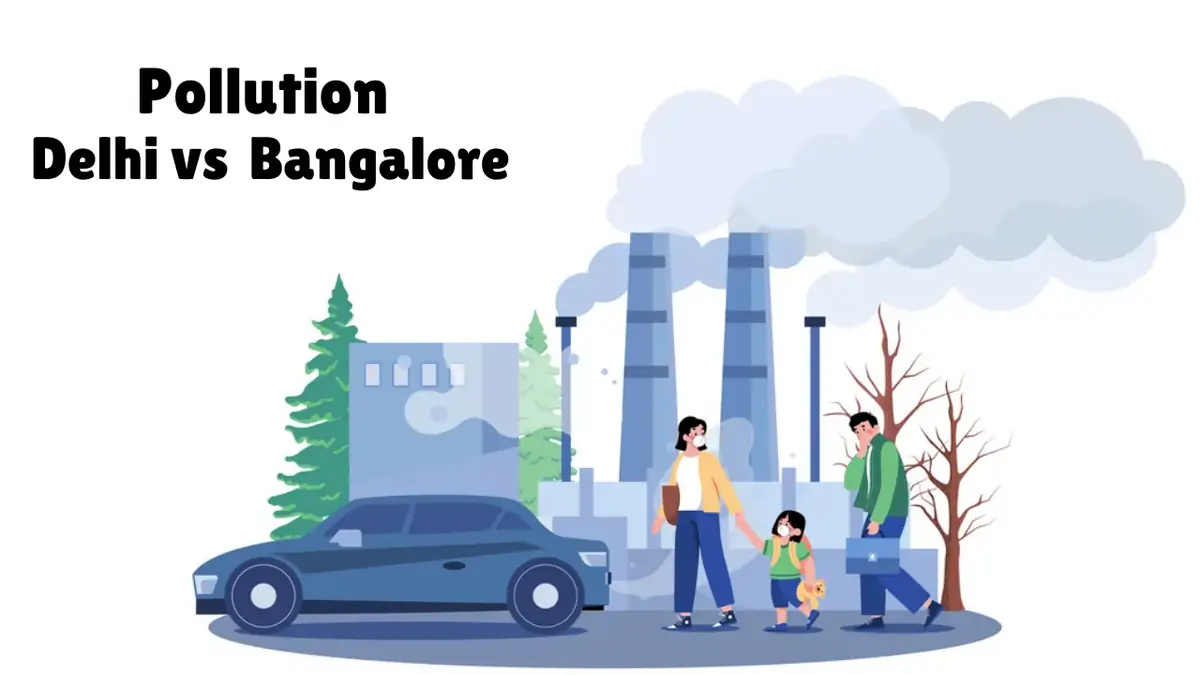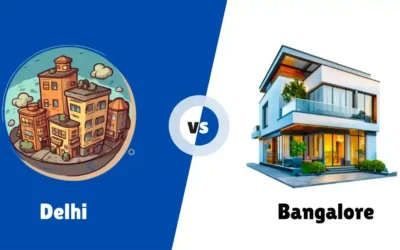When comparing Delhi vs Bangalore, one of the most significant factors to consider is air quality and pollution levels. Pollution not only impacts the environment but also has a direct effect on the health and well-being of residents. Let’s take a closer look at how these two cities fare when it comes to pollution:
Air Quality Of Delhi vs Bangalore
Delhi:
AQI levels of Delhi remain predominantly ‘Unhealthy’ to ‘Hazardous’ almost throughout the year because of vehicle emissions, industrial pollution, dust from construction sites, and seasonal factors. The poorest month is October – November where AQI can go above “severe” (300+) sometimes attaining “hazardous” (500+) pollution. This was due to Diwali fireworks, the burning of agricultural stubble in the neighboring states, and the cold weather which stagnates the pollutants near the ground.
In winter especially between December and February, Delhi has been experiencing long duration of smog and very poor air quality due to slow movement of air masses and temperature inversion. AQI levels during this time are still unhealthy ranging from 200 to 400 violating public health, particularly for vulnerable shoppers such as children, the elderly or people with diseases affecting the lungs.
The AQI tends to be substantially better during the monsoon season which extends from June to September actually might even fall under ‘Moderate ‘ or even’ Satisfactory ‘ (50-100) because of constant rains that reduce pollution. But even in this season, AQI can change and there are contaminated areas due to ongoing urban and industrialization.
Bangalore:
Although Bangalore struggles with pollution, particularly given the growing traffic and construction activities, its air is less polluted compared to that in Delhi. The city has a significant amount of green cover and the climate, which is hospitable all year round, helps in keeping the pollution levels low. In few pockets across Bangalore however, the changing face of urbanism has resulted in increased levels of particulate matter, which is still far from being classified as high.
The AQI of Bangalore varies over the year due to seasonal, urbanization and emissions from traffic movements. Generally, the AQI signifies ‘Good’ to ‘Moderate’ air quality that ranges between 0-100 most of the year including the monsoon period between June through September. Rain therefore serves to wash away air borne pollutants and hence is beneficial to mankind. AQI at this time are usually below 50 thus posing little health risks to the population.
But, Bangalore shows slightly higher AQI during the winter seasons, which are December, January and February. This is because of a process called temperature inversion which brings pollutants closer to the ground; traffic and emissions in growing vehicular population; construction activities and Industries. In winter, AQI levels may touch the ‘Moderate’ (51-100) and at times ‘Unhealthy for Sensitive Group’ ( 101-150) range especially in concentrated traffic zones like Whitefield, Silk Board, and Koramangala
Water Pollution
Delhi:
Another major concern for Delhi is water pollution, particularly in the Yamuna River, which contains extremely high amounts of untreated sewage, industrial waste and agricultural runoff. The availability of drinking water in certain areas is a big concern with residents depending on water purifying systems or bottled water.
Bangalore:
Just like Indian states, Bangalore has also become a victim of water pollution due to the numerous lakes residing in its vicinity. Some of the famous lakes in the city such as Bellandur Lake are severely polluted due to untreated sewage and industrial effluents. Nevertheless, the general water quality of the city is still better managed before that at Delhi but it also needs much more attention and improvement.
Noise Pollution
Delhi:
Noise pollution is everywhere in Delhi from honking and construction noise to incessant road traffic, contributing to high decibel levels all through the day. Those problems are then compounded by festivals and events in densely populated areas —-including weddings.
Bangalore:
The Largest of Indian cities that is Bangalore has a pollution problem, traffic, and noisy horns and you wonder are you still in Murugeshpalya (or Whitefield or Silk Board). Often times these zones are struck by congestion and other symptoms of urban loading. Nevertheless, Bangalore is also known for its green landscape with pocket-friendly localities as Delhi has. But few areas in Bangalore give a clam ambience amidst the hustle of life.
Solid Waste Management
Delhi:
View answer in context The Big change In Delhi Now a concern Turned conscious Towards Waste Management Landfills have been stuffed to the brim so many a time and we hardly segregate our trash. Open dumping and burning of garbage c:lUse air pollution.
Bangalore:
The Bengaluru city, too has taken the steps to handle its share of waste in form of source segregation and composting. Although plastic waste management has been an issue, in comparison to Delhi the city has taken a progressive approach towards solid waste management.
Verdict:
- Delhi has one of the world’s worst air quality, compounded by the issue of serious water pollution levels.
- Bangalore the air in Bangalore is relatively cleaner and waste management initiatives are more prevalent but over-urbanisation means rising pollution concerns.
When it comes to choosing between Delhi vs. Bangalore in terms of pollution, Bangalore emerges as the healthier option.
Delhi vs Bangalore: Pollution Based on Statistics
For example, where Delhi faces more but is harmless to some extent but no physical activities result in smog. Ultrafine particles of CO, Bangalore has a cool climate and many come to use motorbikes too as the industrial emissions are concentrated. Recent stats: Compare the two
Delhi:
- PM2.5 Levels: Delhi frequently records some of the highest levels of PM2.5 (fine particulate matter) in the world, especially during the winter months. The average PM2.5 concentration can be as high as 250-400 µg/m³, which far exceeds the World Health Organization’s (WHO) safe limit of 25 µg/m³.
- AQI (Air Quality Index): During winter, particularly around November (due to Diwali fireworks and stubble burning in neighboring states), Delhi’s AQI can easily cross 300-500. It is classified as “severe” or even “hazardous.”
Primary Pollutants in Delhi
- Vehicle emissions (Delhi has one of the highest vehicle densities in the world)
- Industrial emissions
- Construction dust
- Crop burning in neighboring states (Punjab and Haryana)
Health Impact due to Pollution
- According to reports, long-term exposure to such high levels of air pollution can lead to chronic respiratory issues, heart problems, and a significant reduction in life expectancy.
Bangalore:
- PM2.5 Levels: Bangalore typically has lower PM2.5 levels compared to Delhi. On an average day, PM2.5 concentrations hover around 40-80 µg/m³. Though it can increase during periods of heavy traffic or construction activities.
- AQI (Air Quality Index): Bangalore’s AQI generally ranges between 100-200. It falls under the “moderate” to “unhealthy for sensitive groups” category, depending on the season and traffic conditions.
Primary Pollutants
- Vehicle emissions (increasing with the rise in private car ownership)
- Dust from construction activities
- Traffic congestion (particularly in peak hours)
Health Impact due to Pollution
- While pollution levels are not as high in Bangalore compared to Delhi. But its good that people in the IT capital are getting concerned about rising pollution caused due to growing vehicles and ongoing construction activities. There are certain other pockets in the city, where the air quality tends to slip during peak traffic hours.
Seasonal Differences of Delhi vs Bangalore
- Delhi: Delhi which is situated in North India experiences really hot summers with temperatures reaching around 43 degrees Celsius.
- The winters only punch a hole in the pollution problem in Delhi where pollutants are trapped near the surface due to temperature inversion and stubble burning in neighbouring states.
- Bangalore: In Bangalore as it is a city down south and has regular temperatures changing doesn’t really have issues of temperature inversion. While air quality is relatively consistent throughout the year, it fluctuates slightly during the dry season.
Comparison of Delhi vs Bangalore Pollution
- Delhi’s pollution levels are much higher overall compared to Bangalore. It is because of its unique challenges, including proximity to industrial regions, high vehicle density, and seasonal crop burning.
- Bangalore has better air quality but is still impacted by urbanization and traffic, leading to moderate pollution levels.
Delhi vs Bengaluru: Pollution Comparison
Air Quality:
- Delhi: One of the most polluted cities globally, with severe smog and hazardous AQI levels, especially in winter due to crop burning, vehicular emissions, and industrial pollution.
- Bangalore: Air quality is better, though urbanization and traffic contribute to rising pollution levels. The city’s green cover helps mitigate the issue.
Water Pollution:
- Delhi: The Yamuna River is heavily polluted with untreated sewage and industrial waste.
- Bangalore: Pollution in lakes is a concern, but overall water quality is better managed.
Noise Pollution:
- Delhi: High levels due to traffic, construction, and festivals.
- Bangalore: Noise levels are lower in comparison, especially in residential areas.
Waste Management:
- Delhi: Struggles with overflowing landfills and ineffective waste segregation.
- Bangalore: More progressive, with better waste segregation and composting initiatives.
Conclusion
Bangalore has relatively better air quality and waste management, while Delhi has severe pollution problems over several fronts. Though both cities face challenges of air pollution in their own ways, Delhi is far worse off as compared to the other city especially when the weather conditions worsen to bring about toxic air in certain periods of the year. Bangalore on the other hand has moderate levels of pollution, which is increasing with more urbanization.
However, it’s important to note that the pollution levels in both cities can fluctuate throughout the year. Factors such as weather conditions, wind patterns, and government initiatives can impact air quality.
For the most accurate and up-to-date information on air quality in Delhi and Bangalore, I recommend checking real-time air quality indexes provided by organizations like:
These platforms provide data on various pollutants, including PM2.5, PM10, ozone, and more.


